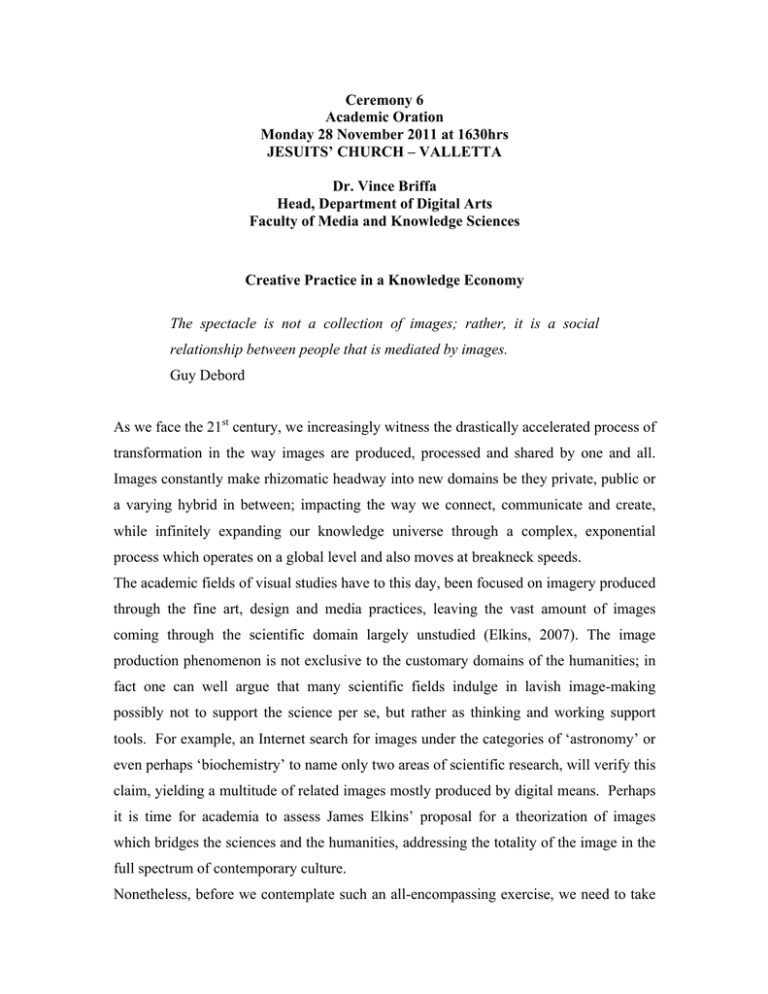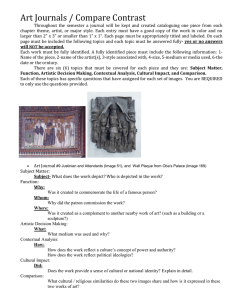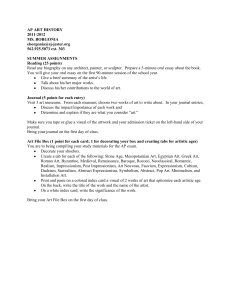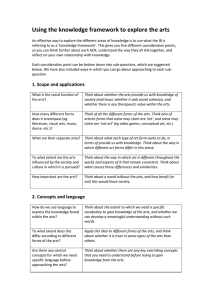Ceremony 6 Academic Oration Monday 28 November 2011 at 1630hrs
advertisement

Ceremony 6 Academic Oration Monday 28 November 2011 at 1630hrs JESUITS’ CHURCH – VALLETTA Dr. Vince Briffa Head, Department of Digital Arts Faculty of Media and Knowledge Sciences Creative Practice in a Knowledge Economy The spectacle is not a collection of images; rather, it is a social relationship between people that is mediated by images. Guy Debord As we face the 21st century, we increasingly witness the drastically accelerated process of transformation in the way images are produced, processed and shared by one and all. Images constantly make rhizomatic headway into new domains be they private, public or a varying hybrid in between; impacting the way we connect, communicate and create, while infinitely expanding our knowledge universe through a complex, exponential process which operates on a global level and also moves at breakneck speeds. The academic fields of visual studies have to this day, been focused on imagery produced through the fine art, design and media practices, leaving the vast amount of images coming through the scientific domain largely unstudied (Elkins, 2007). The image production phenomenon is not exclusive to the customary domains of the humanities; in fact one can well argue that many scientific fields indulge in lavish image-making possibly not to support the science per se, but rather as thinking and working support tools. For example, an Internet search for images under the categories of ‘astronomy’ or even perhaps ‘biochemistry’ to name only two areas of scientific research, will verify this claim, yielding a multitude of related images mostly produced by digital means. Perhaps it is time for academia to assess James Elkins’ proposal for a theorization of images which bridges the sciences and the humanities, addressing the totality of the image in the full spectrum of contemporary culture. Nonetheless, before we contemplate such an all-encompassing exercise, we need to take stock of our current image-making condition and set it against a global perspective, perhaps starting where traditionally all image-making takes root, that is in fine art, design and media practice. In the last quarter of a century, global cultural production has expanded far beyond any previous occurrence in the history of the visual arts. We have witnessed the flattening of artistic practice which resulted in no one dominating discipline, style or indeed genre, and with no prevailing artists’ movement. The consequential democratization of the image has given rise to a production that is possibly more focused on matters and concerns of a social nature rather than aesthetics, one that prefers the new tools of the Internet and social networks to convey its issues, and more importantly one that speculates on remediating society’s epistemological and ontological status perhaps even to heights of unexpected consequence. Against such a complex and ever changing backdrop of melded art, technology and science, a call to arms to seriously reflect on and readdress visual studies within our shores from the ground up in order to seize such potentially huge opportunities while responsibly assessing their intrinsic risks comes as no surprise. Students, particularly those who enter higher institutions, are already party to social networks and increased mobility and equipped with a language built through the use of a multiplicity of cross bridging tools in constant evolution, capable of generating, recording and exchanging information and knowledge. Education in the visual arts is being challenged by informal and dispersed learning and exchange, a phenomenon which highlights our urgent need to seriously consider further focusing on an art education built on multidisciplinary research and interdisciplinary production. Consequently, relevant contemporary visual art and design instruction has to be founded on a process that recognizes the importance of training for the refinement of artistic sensibility. This instruction, furthermore, not only considers the explosion of the image and its multitude of dissemination platforms as added tools of opportunity, but also finds alignment within an appropriate contextual, social and historical framework in order to create meaning. This pivotal, perhaps even historical perceptual change that is happening in the way we integrate what we create with how we communicate it, places new sets of demands on our art and design education establishment. Education in the arts needs to re-imagine and redefine its role and relevance in order to address the ever-widening chasm between past and present modes of how we perceive the artistic outcome in terms of its aesthetics, production and frame of reference. Such an approach mandates embracing new translations of form and content due to multi-culturalism. It also beckons us to ensure that the phenomenon of immediate universal access becomes a central node to consider in the students’ artistic preparation for the future. The challenge we face is not simply one of integration of the conventional with the new, but rather one of establishing innovative processes of homogenization, where these new creative tools become equally important to their more traditional counterparts, even developing strategies of seamless interfacing, and more importantly locating the vast amounts of creative opportunities they bring into being. Sited within a solid practicebased research framework, this process will ultimately deliver students’ outcomes that revolve around issues which are relevant to contemporary artistic sensibilities, steadily push the boundaries of creativity and innovation and most importantly are in the context of today’s needs and realities. Establishing a creative process of intertwined practice and reflection is a praxis which is not only about making, but also about creating networks, facilitating conditions and drawing from the vast conceptual and material resources of our cultural, social, political and institutional collective. Sustainable artmaking must address a multitude of issues in order for it to be successful. The next surge of our cultural production has to come from a creative who transcends the unfortunately still popular notion of the artist or designer as mere fabrication technician. Our task is to re-establish the Renaissance being – a creative who not only skillfully employs a multitude of disciplines and mediums, but also possesses a deep understanding of the patterns of creativity and is sustained by a referential baggage of substance and a strong sense of self-criticism. Our creative climate needs to be strengthened further through a systematic approach that promotes informed experimentation as a constantly evolving process that goes beyond craft, techniques and tools. It impels us toward a creative standpoint that rises well above the then historically important and still popular, art-for-art’s-sake belief only to serve purposes of mere decoration or commodity. Through its many artists, Modernism has shown us time and again that it can so sublimely determine its omnipresence through its forms, often underpinned through the artist’s interiority, which essentially asserts the individual and segregates artistic production from lived reality. Although such ideals have left their indelible mark on culture’s history, this formula proves irrelevant to contemporary artistic sensibility. Repeating it would reduce the outcome to nothing more than ornament, which unfortunately not only seems sterile, but deprives social content and excludes art’s deserved commitment to address and even criticize its tenets. The key to affirm relevance and strengthen the quality of visual art practice needs to be one that opens a multitude of locks. At the very roots of art education, particularly, but not exclusively at tertiary level, we need to continue to strengthen our notable means of production through information that is conceptually driven and verbalized through a multidisciplinary methodology. The basic toolbox which should serve our students’ artistic foundation, needs to include a set of conceptualizing tools. These tools comprise scholarly research, literary writing and a historical frame of reference to make expressive action more cognisant and eloquent, balancing talent with thinking, knack with knowledge. It needs to educate students to use their visual and verbal skills to analyse and assess other disciplines of relevance, extracting merits and re-programming them to nourish creative formation. The challenge in putting together the right toolbox lies in keeping it always open for the inclusion of new tools that help to enhance the intellectual diversity and creative flexibility of the student. This ongoing process needs to be complemented with urgently needed, adequate studio spaces and facilities that not only permit students to experiment across media and disciplines, but also serve as showcases for the same creative process. It is on this framework of interdisciplinarity and creative flexibility that the Department of Digital Arts within the Faculty of Media and Knowledge Sciences or MaKS as it is colloquially known, has structured its Master of Fine Arts in Digital Arts degree which has been launched this academic year. In collaboration with the Faculty of Education, the Faculty of Built Environment and the Department of English, MaKS has created an umbrella Master’s degree that covers and crosses between areas of visual image research which include the digital arts, the plastic arts, visual communications, the moving image and photography. I am certain that the degree will substantially contribute to the professionalization of creative practice and help increase the pool of individuals who, through the cross-disciplinary nature of their work increasingly defy pigeon-holing; who are both visual artists and scholars, creatives as well as intellectuals and dynamic cultural operators who are actively involved in a global society. The MFA in Digital Arts will contribute to establishing further respect for the profession of the visual creative and the reinforcement of the local creative economy –a sector which has been identified as a major source of value added generation in the Maltese economy. It currently accounts for 4% of the country’s GDP. Statistics indicate that the local Cultural and Creative Industries have experienced an average growth of 9% between 2001 and 2007, and a 60% increase totalizing 23 million Euro, in the export of cultural and creative services between 2004 and 2008 (MFEI, 2010). We sincerely hope that our students will further brighten these statistics not only in numbers but also through the quality of their product. A more sophisticated visual communications education empowers the professional artist and designer in no small way. Carol Becker (1993), the current dean of Columbia University’s School of the Arts advises that, educators should guide artists to help viewers through their work’s complexity: “That is what art students find most difficult to actualize. They themselves do not always know how they arrived at their own images, so they are unsure of what information is necessary to give people. And yet the amount of ‘information’ revealed by a work of art is the measure of how much power an artist gives to an audience.” Naturally, power brings with it due responsibility. Reflecting on social commentary and the artist’s responsibilities in a short documentary directed by Hillman Curtis, legendary designer Milton Glaser (2008) observes: “… I’ve always believed because you have access to people’s minds and you communicate to people there is a corresponding responsibility, the responsibility of being a good citizen. And also recognizing that you have the ability to transfer ideas from one point to another, that those should be ideas that cause no harm. So it doesn’t matter so much whether graphic design is an effective vehicle as much for personal reasons, you want to be operating within the life of your time – you want to do things that have some relationship to your community, to your family, to your city, to your country, to the world.” The final, but perhaps most important tool which I would like to add to the students’ creative toolbox, is also highlighted by Milton Glaser in the same documentary. It is the ability to sustain a sense of wonder and a capacity for astonishment for the creative act. The great benefit of being in the arts continually provides such a sense of amazement, and when an artist loses this quality, or worse never experiences it, it really is a great loss, as the world is indeed a very astonishing place. References Debord, G. (2008). The Society of the Spectacle, sec. 4, tr. Donald Nicholson-Smith, Zone Books, p. 12. Elkins, J. (Ed.). (2007).Visual Practices across the University, Munich: Vilhelm Fink Verlag. Ministry of Finance, the Economy and Investment, 2010. Annual Report. Becker, C. (1993).The Education of Young Artists and the Issue of Audience, Cultural Studies 7, Issue 1, Taylor and Francis, pp. 46–57. Glaser, M. (2008). Title: Milton Glaser (Artist Series). Directed, shot and edited by Hillman Curtis, produced by Karen Schneider/Adobe.





